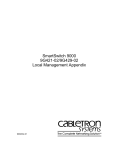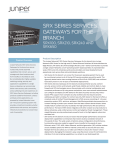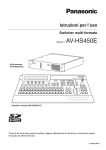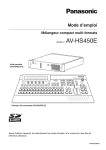Download Enterasys XPEDITION ER16 Router (er16-hfx39-24)
Transcript
CLASS 1 LASER TRANSCEIVERS NOTICE Enterasys Networks and its licensors reserve the right to make changes in specifications and other information contained in this document without prior notice. The reader should in all cases consult Enterasys Networks to determine whether any such changes have been made. The hardware, firmware, or software described in this manual is subject to change without notice. IN NO EVENT SHALL ENTERASYS NETWORKS AND ITS LICENSORS BE LIABLE FOR ANY INCIDENTAL, INDIRECT, SPECIAL, OR CONSEQUENTIAL DAMAGES WHATSOEVER (INCLUDING BUT NOT LIMITED TO LOST PROFITS) ARISING OUT OF OR RELATED TO THIS MANUAL OR THE INFORMATION CONTAINED IN IT, EVEN IF ENTERASYS NETWORKS AND ITS LICENSORS HAVE BEEN ADVISED OF, KNOWN, OR SHOULD HAVE KNOWN, THE POSSIBILITY OF SUCH DAMAGES. Enterasys Networks, Inc. 35 Industrial Way Rochester, NH 03866-5005 2001 by Enterasys Networks, Inc. All Rights Reserved Printed in the United States of America THE GPIM-08 AND GMIP-09 GIGABIT PORT INTERFACE MODULES, USE CLASS 1 LASER TRANSCEIVERS. READ THE FOLLOWING SAFETY INFORMATION BEFORE INSTALLING OR OPERATING THESE MODULES. The Class 1 laser transceivers use an optical feedback loop to maintain Class 1 operation limits. This control loop eliminates the need for maintenance checks or adjustments. The output is factory set, and does not allow any user adjustment. Class 1 Laser transceivers comply with the following safety standards: • 21 CFR 1040.10 and 1040.11 U.S. Department of Health and Human Services (FDA). • IEC Publication 825 (International Electrotechnical Commission). • Order Number: 9033757 September 2001 CENELEC EN 60825 (European Committee for Electrotechnical Standardization). When operating within their performance limitations, laser transceiver output meets the Class 1 accessible emission limit of all three standards. Class 1 levels of laser radiation are not considered hazardous. SAFETY INFORMATION CLASS 1 LASER TRANSCEIVERS LASER RADIATION AND CONNECTORS X-Pedition and Enterasys Networks are registered trademarks of Enterasys Networks or its licensors. All other product names mentioned in this manual may be trademarks or registered trademarks of their respective companies. FCC NOTICE This device complies with Part 15 of the FCC rules. Operation is subject to the following two conditions: (1) this device may not cause harmful interference, and (2) this device must accept any interference received, including interference that may cause undesired operation. NOTE: This equipment has been tested and found to comply with the limits for a class A digital device, pursuant to Part 15 of the FCC rules. These limits are designed to provide reasonable protection against harmful interference when the equipment is operated in a commercial environment. This equipment uses, generates, and can radiate radio frequency energy and if not installed in accordance with the operator’s manual, may cause harmful interference to radio communications. Operation of this equipment in a residential area is likely to cause interference in which case the user will be required to correct the interference at his own expense. WARNING: Changes or modifications made to this device which are not expressly approved by the party responsible for compliance could void the user’s authority to operate the equipment. When the connector is in place, all laser radiation remains within the fiber. The maximum amount of radiant power exiting the fiber (under normal conditions) is -12.6 dBm or 55 x 10-6 watts. ER16-HFX39-24 & ER16-HFX31-24 CONNECTIVITY GUIDELINES The ER16-HFX39-24 and ER16-HFX31-24 are 24-port, 100Base-FX EthernetModules for the ER16 platform. The ER16-HFX39-24 and ER16-HFX31-24 use 24 MT-RJ connectors and deliver full-function Layer-2, Layer-3, and Layer-4 switching and routing. ER16-HFX31-24 Table 1 100Base-FX Multi-Mode Fiber Specifications SPECIFICATIONS Ports 24 Ports with 24 MT-RJ connectors T-series (Enterasys) Switch Method INDUSTRY CANADA NOTICE European Representative Name: European Representative Address: This digital apparatus does not exceed the class A limits for radio noise emissions from digital apparatus set out in the Radio Interference Regulations of the Canadian Department of Communications. Le présent appareil numérique n’émet pas de bruits radioélectriques dépassant les limites applicables aux appareils numériques de la class A prescrites dans le Règlement sur le brouillage radioélectrique édicté par le ministère des Communications du Canada. Conformance to Directive(s)/ Product Standards: VCCI NOTICE This is a class A product based on the standard of the Voluntary Control Council for Interference by Information Technology Equipment (VCCI). If this equipment is used in a domestic environment, radio disturbance may arise. When such trouble occurs, the user may be required to take corrective actions. Equipment Type/Environment: 62.5/125 µm 160 MHz/km 2-220 m (7-722 ft) MT-RJ 200 MHz/km 2-275 m (7-902 ft) MT-RJ 400 MHz/km 2-500 m (7-1641 ft) MT-RJ 500 MHz/km 2-550 m (7-1805 ft) MT-RJ ER16-HFX39-24 Table 2 100Base-FX Single-Mode Fiber Specifications Address-based and Flow-based. Queue Buffer Packet memory size: 4MB per port Fiber Diameter Modal Bandwidth Range Connector Physical Dimensions 10/125 µm N/A 2-10000 m (6.2 mi) MT-RJ Size: 52.9 cm H x 2.9 W x 40.1 D (20.9 in. H x 1.15 W x 15.8 D) Weight: 3.27 kg (7.2 lbs) OPTICS Power Consumption Temperature Manufacturer’s Name: Manufacturer’s Address: Connector MT-RJ Connectors Do not use optical instruments to view the laser output. The use of optical instruments to view laser output increases eye hazard. When viewing the output optical port, power must be removed from the network adapter. 89/336/EEC 73/23/EEC Enterasys Networks, Inc. 35 Industrial Way PO Box 5005 Rochester, NH 03867 Mr. Jim Sims Enterasys Networks Ltd. Nexus House, Newbury Business Park London Road, Newbury Berkshire RG14 2PZ, England Range 50/125 µm Network Interfaces BTU/hr = 306 AC Volt Amps = 90 Application of Council Directive(s): Modal Bandwidth ASIC Type Removing the optical connector from the transceiver allows laser radiation to emit directly from the optical port. The maximum radiance from the optical port (under worst case conditions) is 0.8 W cm-2 or 8 x 103 W m2 sr-1. DECLARATION OF CONFORMITY Fiber Diameter Table 3 Operating: 41° to 104° F (5° to 40° C) Storage: -22° to 164° F (-30° to 73° C) Humidity ER16-HFX31-24 Multi-Mode 1300 nm Receiver Sensitivity Transmit Power 62.5/125 µm Transmit Power 50/125 µm Minimum -31.8 dBm Minimum -20 dBm Minimum -23.5 dBm Maximum -14 dBm Maximum -14 dBm Maximum -14 dBm 15% to 90% (non-condensing) Table 4 ER16-HFX39-24 Single-Mode 1300 nm Receiver Sensitivity Transmit Power Minimum -31.8 dBm Minimum -20 dBm Maximum -8 dBm Maximum -14 dBm LEDs EC Directive 89/336/EEC EC Directive 73/23/EEC EN 55022 EN 55024 EN 60950 EN 60825 Networking Equipment, for use in a Commercial or Light Industrial Environment. Table 5 Enterasys Networks, Inc. declares that the equipment packaged with this notice conforms to the above directives. AGENCY STANDARDS LED Indicators LED Condition Status A valid link has been established on the port. Link Green Activity Flashing Yellow Traffic is passing through the port. Online Green The module is online, or the module was hotswapped successfully. Offline Yellow The module is receiving power, but is dormant or hotswapped out. Safety CLASS A ITE NOTICE WARNING: This is a class A product. In a domestic environment this product may cause radio interference in which case the user may be required to take adequate measures. Meets the requirements of UL 1950, CSA C22.2 No. 950, EN 60950, EN 60825, IEC 950, and 73/23/EEC. Electromagnetic Compatibility Compliant with the requirements of FCC Part 15, CSA C108.8, EN 55022, VCCI V-3, EN 55024, EN 61000-3-2, EN 61000-3-3, and 89/336/EEC. SAFETY INFORMATION 1 2 INSTALLING THE MODULE WARNING: Do not use optical instruments to view the laser output. The use of optical instruments to view laser output increases eye hazard. When viewing the output optical port, power must be removed from the network adapter. ELECTRICAL HAZARD: Only qualified personnel should perform installation procedures. Handling the Module CAUTION: Before performing any upgrade or installation, ensure that you are properly “grounded” to avoid electrostatic discharge. 1. If a coverplate is installed in the slot where you will insert the module, remove the coverplate: loosen the screws on the ejectors until the screws pop out, then open the ejectors and pull out the plate. Open the ejectors at the top and bottom of the module. Align the metal backpanel of the module with the card guides at the top and the bottom of the slot opening, as shown in Figure 1. 2. 3. CAUTION: The ER16-HFX39-24 and ER16-HFX31-24 are designed for slots 1-7 or 9-16 only, and are easily damaged by electrostatic discharge. To prevent electrostatic damage, observe the following guidelines: Do not remove the module from its packaging until you are ready to install it. Do not touch any of the module’s pins, connectors or components. Hold the module only by its edges or front panel. Wear an anti-static wristband connected to a suitable earth ground whenever handling the module. Store or transport this module only in appropriate anti-static packaging. • • • • • TROUBLESHOOTING Instructions NOTE: Make sure that the metal backpanel of the module—not the circuit card—is between the card guides. Check both the upper and lower tracks. 4. Slide the module all the way into the slot, firmly but gently pressing to ensure that the pins on the back of the module are completely seated in the backplane. To lock the ER16-HFX39-24 or ER16-HFX31-24 into the slot, close the ejectors. Using a flathead screwdriver, tighten the screw on each ejector. 5. Figure 1 Install the ER16-HFX39-24 or ER16-HFX31-24 After unpacking the ER16-HFX39-24 or ER16-HFX31-24, check the contents of the box to be sure you received the following items: One ER16-HFX39-24 or ER16-HFX31-24 module in anti-static bag One disposable anti-static wristband Offline LED lights at power-up. Port LEDs flicker briefly during system boot while ports initialize. Online LED turns on once module is active. Common Errors • • • The ER16 is not powered up. The module is not properly seated in the slot. Connectors on both ends of the cable are not properly engaged. The cable attached to the port did not click into place or is not properly seated. Helpful CLI Commands for Debugging • • • System show hardware System show version System show bootlog ADDITIONAL INFORMATION Quick Start For additional support related to the Common CLI syntax or this document, contact Enterasys Networks using one of the following methods: Tools This installation requires the following tools: Rotate ejector to lock in place Flathead screwdriver Circuit Card Metal Backpanel Preliminary Setup Hotswap You may install this module into a live system without powering off the device. However, do not remove an active module from a live system except under the following conditions: Press the Hotswap button. The Online LED will turn off and the Offline LED will turn on. Remove the module. LNK ACT • • (603) 332-9400 Internet mail [email protected] FTP Login Password ftp://ftp.enterasys.com anonymous your email address To acquire the latest image for this product and any available release notes http://www.enterasys.com/download Additional documentation http://www.enterasys.com/support/manuals • • • • • • OR... ONLINE OFFLINE HOT SWAP Firmware Image Requirements http://www.enterasys.com/ Phone Before contacting Enterasys Networks for technical support, have the following information ready: LNK = Link Status ACT = Activity (Rx/Tx) Enter the following from the CLI and click enter: Enable -> System -> Hotswap -> Out -> Slot -> #. The Online LED will turn off and the Offline LED will turn on. Remove the module. World Wide Web To send comments or suggestions concerning this document, contact the Technical Writing Department via the following email address: [email protected] Please include the document Part Number in the email message. Card Guides Your Enterasys Networks service contract number A description of the failure A description of any action(s) taken to resolve the problem (e.g., changing mode switches, rebooting the unit) The serial and revision numbers of all involved Enterasys Networks products in the network A description of your network environment (layout, cable type, etc.) Network load and frame size at the time of trouble (if known) Version 8.3.0.0 or later. ONLINE OFFLINE HOT SWAP 3 ER16-HFX39-24 ER16-HFX31-24 Getting Help • • • • • • • For additional information about installing this module or to learn more about what capabilities are included in the firmware release you are using, visit the Enterasys Networks web site. Equipment Checklist Anti-static wristband Proper Boot Sequence 4 5 Web Site: http://www.enterasys.com/ 9033757












